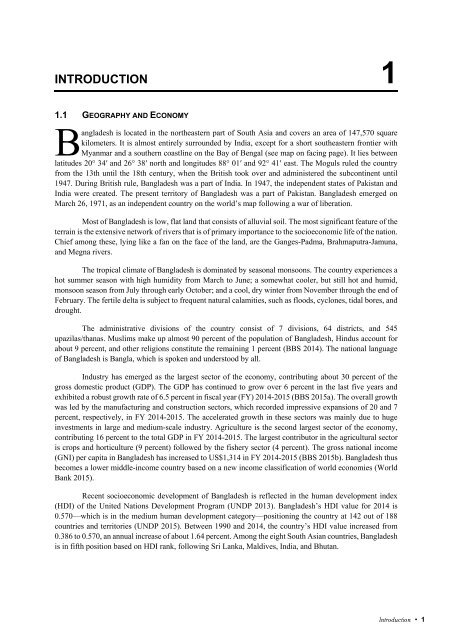Bangladesh 2014
8ln3LMTjp
8ln3LMTjp
Create successful ePaper yourself
Turn your PDF publications into a flip-book with our unique Google optimized e-Paper software.
INTRODUCTION 1<br />
1.1 GEOGRAPHY AND ECONOMY<br />
<strong>Bangladesh</strong> is located in the northeastern part of South Asia and covers an area of 147,570 square<br />
kilometers. It is almost entirely surrounded by India, except for a short southeastern frontier with<br />
Myanmar and a southern coastline on the Bay of Bengal (see map on facing page). It lies between<br />
latitudes 20° 34′ and 26° 38′ north and longitudes 88° 01′ and 92° 41′ east. The Moguls ruled the country<br />
from the 13th until the 18th century, when the British took over and administered the subcontinent until<br />
1947. During British rule, <strong>Bangladesh</strong> was a part of India. In 1947, the independent states of Pakistan and<br />
India were created. The present territory of <strong>Bangladesh</strong> was a part of Pakistan. <strong>Bangladesh</strong> emerged on<br />
March 26, 1971, as an independent country on the world’s map following a war of liberation.<br />
Most of <strong>Bangladesh</strong> is low, flat land that consists of alluvial soil. The most significant feature of the<br />
terrain is the extensive network of rivers that is of primary importance to the socioeconomic life of the nation.<br />
Chief among these, lying like a fan on the face of the land, are the Ganges-Padma, Brahmaputra-Jamuna,<br />
and Megna rivers.<br />
The tropical climate of <strong>Bangladesh</strong> is dominated by seasonal monsoons. The country experiences a<br />
hot summer season with high humidity from March to June; a somewhat cooler, but still hot and humid,<br />
monsoon season from July through early October; and a cool, dry winter from November through the end of<br />
February. The fertile delta is subject to frequent natural calamities, such as floods, cyclones, tidal bores, and<br />
drought.<br />
The administrative divisions of the country consist of 7 divisions, 64 districts, and 545<br />
upazilas/thanas. Muslims make up almost 90 percent of the population of <strong>Bangladesh</strong>, Hindus account for<br />
about 9 percent, and other religions constitute the remaining 1 percent (BBS <strong>2014</strong>). The national language<br />
of <strong>Bangladesh</strong> is Bangla, which is spoken and understood by all.<br />
Industry has emerged as the largest sector of the economy, contributing about 30 percent of the<br />
gross domestic product (GDP). The GDP has continued to grow over 6 percent in the last five years and<br />
exhibited a robust growth rate of 6.5 percent in fiscal year (FY) <strong>2014</strong>-2015 (BBS 2015a). The overall growth<br />
was led by the manufacturing and construction sectors, which recorded impressive expansions of 20 and 7<br />
percent, respectively, in FY <strong>2014</strong>-2015. The accelerated growth in these sectors was mainly due to huge<br />
investments in large and medium-scale industry. Agriculture is the second largest sector of the economy,<br />
contributing 16 percent to the total GDP in FY <strong>2014</strong>-2015. The largest contributor in the agricultural sector<br />
is crops and horticulture (9 percent) followed by the fishery sector (4 percent). The gross national income<br />
(GNI) per capita in <strong>Bangladesh</strong> has increased to US$1,314 in FY <strong>2014</strong>-2015 (BBS 2015b). <strong>Bangladesh</strong> thus<br />
becomes a lower middle-income country based on a new income classification of world economies (World<br />
Bank 2015).<br />
Recent socioeconomic development of <strong>Bangladesh</strong> is reflected in the human development index<br />
(HDI) of the United Nations Development Program (UNDP 2013). <strong>Bangladesh</strong>’s HDI value for <strong>2014</strong> is<br />
0.570—which is in the medium human development category—positioning the country at 142 out of 188<br />
countries and territories (UNDP 2015). Between 1990 and <strong>2014</strong>, the country’s HDI value increased from<br />
0.386 to 0.570, an annual increase of about 1.64 percent. Among the eight South Asian countries, <strong>Bangladesh</strong><br />
is in fifth position based on HDI rank, following Sri Lanka, Maldives, India, and Bhutan.<br />
Introduction • 1


